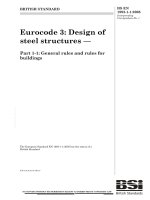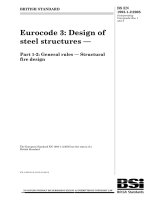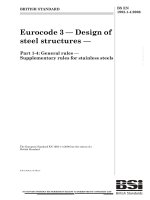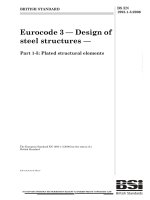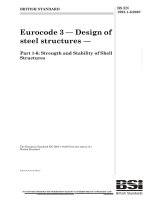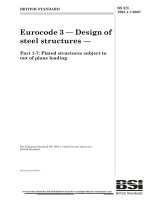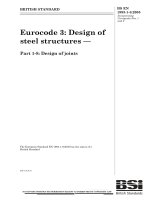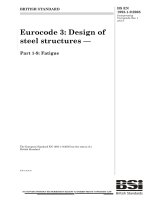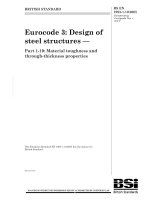Tiêu chuẩn Châu Âu EC6: Kết cấu gạch đá phần 1.1: Quy định chung (Eurocode6 EN1996 1 1 e 2005 Design of masonry structures part 1.1: General rules for reinforced and unreinforced masonry structures)
Bạn đang xem bản rút gọn của tài liệu. Xem và tải ngay bản đầy đủ của tài liệu tại đây (685.57 KB, 123 trang )
EUROPEAN STANDARD
EN 1996-1-1
NORME EUROPÉENNE
EUROPÄISCHE NORM
November 2005
ICS 91.010.30; 91.080.30
Supersedes ENV 1996-1-1:1995, ENV 1996-1-3:1998
English Version
Eurocode 6 - Design of masonry structures - Part 1-1: General
rules for reinforced and unreinforced masonry structures
Eurocode 6 - Calcul des ouvrages en maçonnerie - Partie
1-1: Règles communes pour ouvrages en maçonnerie
armée et non armée
Eurocode 6 - Bemessung und Konstruktion von
Mauerwerksbauten - Teil 1-1: Allgemeine Regeln für
bewehrtes und unbewehrtes Mauerwerk
This European Standard was approved by CEN on 23 June 2005.
CEN members are bound to comply with the CEN/CENELEC Internal Regulations which stipulate the conditions for giving this European
Standard the status of a national standard without any alteration. Up-to-date lists and bibliographical references concerning such national
standards may be obtained on application to the Central Secretariat or to any CEN member.
This European Standard exists in three official versions (English, French, German). A version in any other language made by translation
under the responsibility of a CEN member into its own language and notified to the Central Secretariat has the same status as the official
versions.
CEN members are the national standards bodies of Austria, Belgium, Cyprus, Czech Republic, Denmark, Estonia, Finland, France,
Germany, Greece, Hungary, Iceland, Ireland, Italy, Latvia, Lithuania, Luxembourg, Malta, Netherlands, Norway, Poland, Portugal, Slovakia,
Slovenia, Spain, Sweden, Switzerland and United Kingdom.
EUROPEAN COMMITTEE FOR STANDARDIZATION
COMITÉ EUROPÉEN DE NORMALISATION
EUROPÄISCHES KOMITEE FÜR NORMUNG
Management Centre: rue de Stassart, 36
© 2005 CEN
All rights of exploitation in any form and by any means reserved
worldwide for CEN national Members.
B-1050 Brussels
Ref. No. EN 1996-1-1:2005: E
EN 1996-1-1:2005 (E)
Contents
Page
Background to the Eurocode programme......................................................................................... 7
Status and field of application of Eurocodes..................................................................................... 8
National Standards implementing Eurocodes .................................................................................. 9
Links between Eurocodes and harmonised technical specifications (ENs and ETAs) for
products .................................................................................................................................... 9
National Annex for EN 1996-1-1 ...................................................................................................... 10
1
1.1
1.1.1
1.1.2
1.1.3
1.2
1.2.1
1.2.2
1.3
1.4
1.5
1.5.1
1.5.2
1.5.3
1.5.4
1.5.5
1.5.6
1.5.7
1.5.8
1.5.9
1.5.10
1.5.11
1.6
General ................................................................................................................................... 11
Scope ....................................................................................................................................... 11
Scope of Eurocode 6 .............................................................................................................. 11
Scope of Part 1-1 of Eurocode 6 ........................................................................................... 11
Further Parts of Eurocode 6................................................................................................. 12
Normative references ............................................................................................................ 13
General ................................................................................................................................... 13
Reference standards .............................................................................................................. 13
Assumptions ........................................................................................................................... 14
Distinction between principles and application rules......................................................... 14
Terms and Definitions ........................................................................................................... 15
General ................................................................................................................................... 15
Terms relating to masonry.................................................................................................... 15
Terms relating to strength of masonry ................................................................................ 15
Terms relating to masonry units .......................................................................................... 16
Terms relating to mortar ...................................................................................................... 17
Terms relating to concrete infill ........................................................................................... 18
Terms relating to reinforcement .......................................................................................... 18
Terms relating to ancillary components.............................................................................. 18
Terms relating to mortar joints............................................................................................ 19
Terms relating to wall types ................................................................................................. 19
Miscellaneous terms .............................................................................................................. 20
Symbols................................................................................................................................... 21
2
2.1
2.1.1
2.1.2
2.1.3
2.2
2.3
2.3.1
2.3.2
2.3.3
2.4
2.4.1
Basis of design ........................................................................................................................ 27
Basic requirements ................................................................................................................ 27
General ................................................................................................................................... 27
Reliability ............................................................................................................................... 27
Design working life and durability....................................................................................... 27
Principles of limit state design.............................................................................................. 27
Basic variables........................................................................................................................ 28
Actions .................................................................................................................................... 28
Design values of actions......................................................................................................... 28
Material and product properties.......................................................................................... 28
Verification by the partial factor method............................................................................ 28
Design values of material properties.................................................................................... 28
2
EN 1996-1-1:2005 (E)
2.4.2 Combination of actions ..........................................................................................................28
2.4.3 Ultimate limit states ...............................................................................................................28
2.4.4 Serviceability limit states .......................................................................................................29
2.5
Design assisted by testing.......................................................................................................29
3
3.1
3.1.1
3.1.2
3.2
3.2.1
3.2.2
3.2.3
3.3
3.3.1
3.3.2
3.3.3
3.4
3.4.1
3.4.2
3.4.3
3.5
3.6
3.6.1
3.6.2
3.6.3
3.6.4
3.7
3.7.1
3.7.2
3.7.3
3.7.4
3.8
3.8.1
3.8.2
3.8.3
3.8.4
3.8.5
Materials .................................................................................................................................30
Masonry Units ........................................................................................................................30
Types and grouping of masonry units ..................................................................................30
Properties of masonry units –compressive strength ...........................................................32
Mortar .....................................................................................................................................32
Types of masonry mortar ......................................................................................................32
Specification of masonry mortar ..........................................................................................32
Properties of mortar...............................................................................................................33
Concrete infill .........................................................................................................................33
General ....................................................................................................................................33
Specification for concrete infill .............................................................................................33
Properties of concrete infill ...................................................................................................33
Reinforcing steel .....................................................................................................................34
General ....................................................................................................................................34
Properties of reinforcing steel bars.......................................................................................34
Properties of prefabricated bed joint reinforcement ..........................................................34
Prestressing steel ....................................................................................................................35
Mechanical properties of masonry .......................................................................................35
Characteristic compressive strength of masonry ................................................................35
Characteristic shear strength of masonry............................................................................38
Characteristic flexural strength of masonry........................................................................40
Characteristic anchorage strength of reinforcement..........................................................42
Deformation properties of masonry .....................................................................................43
Stress-strain relationship.......................................................................................................43
Modulus of elasticity ..............................................................................................................44
Shear modulus ........................................................................................................................44
Creep, moisture expansion or shrinkage and thermal expansion .....................................45
Ancillary components ............................................................................................................45
Damp proof courses ...............................................................................................................45
Wall ties...................................................................................................................................45
Straps, hangers and brackets ................................................................................................46
Prefabricated lintels ...............................................................................................................46
Prestressing devices................................................................................................................46
4
4.1
4.2
4.3
4.3.1
4.3.2
4.3.3
4.3.4
4.3.5
4.3.6
4.4
Durability ................................................................................................................................46
General ....................................................................................................................................46
Classification of environmental conditions ..........................................................................46
Durability of masonry............................................................................................................46
Masonry units .........................................................................................................................46
Mortar .....................................................................................................................................46
Reinforcing steel .....................................................................................................................46
Prestressing steel ....................................................................................................................48
Prestressing devices................................................................................................................49
Ancillary components and support angles ...........................................................................49
Masonry below ground ..........................................................................................................49
3
EN 1996-1-1:2005 (E)
5
5.1
5.2
5.3
5.4
5.5
5.5.1
5.5.2
5.5.3
5.5.4
5.5.5
Structural analysis................................................................................................................. 49
General ................................................................................................................................... 49
Structural behaviour in accidental situations (other than earthquakes and fire)........... 50
Imperfections ......................................................................................................................... 50
Second order effects............................................................................................................... 51
Analysis of structural members............................................................................................ 51
Masonry walls subjected to vertical loading ....................................................................... 51
Reinforced masonry members subjected to vertical loading............................................. 57
Masonry shear walls subjected to shear loading ................................................................ 60
Reinforced masonry members subjected to shear loading ................................................ 62
Masonry walls subjected to lateral loading......................................................................... 62
6
6.1
6.1.1
6.1.2
6.1.3
6.2
6.3
6.3.1
6.3.2
6.3.3
6.3.4
6.3.5
6.4
6.4.1
6.4.2
6.4.3
6.4.4
6.5
6.6
Ultimate Limit State .............................................................................................................. 64
Unreinforced masonry walls subjected to mainly vertical loading................................... 64
General ................................................................................................................................... 64
Verification of unreinforced masonry walls subjected to mainly vertical loading.......... 64
Walls subjected to concentrated loads................................................................................. 67
Unreinforced masonry walls subjected to shear loading ................................................... 70
Unreinforced masonry walls subjected to lateral loading ................................................. 70
General ................................................................................................................................... 70
Walls arching between supports .......................................................................................... 72
Walls subjected to wind loading........................................................................................... 73
Walls subjected to lateral loading from earth and water .................................................. 73
Walls subjected to lateral loading from accidental situations........................................... 73
Unreinforced masonry walls subjected to combined vertical and lateral loading .......... 74
General ................................................................................................................................... 74
Method using Φ factor........................................................................................................... 74
Method using apparent flexural strength............................................................................ 74
Method using equivalent bending coefficients .................................................................... 74
Ties .......................................................................................................................................... 74
Reinforced masonry members subjected to bending, bending and axial loading, or
axial loading ........................................................................................................................... 75
General ................................................................................................................................... 75
Verification of reinforced masonry members subjected to bending and/or axial
loading..................................................................................................................................... 76
Flanged Reinforced Members .............................................................................................. 78
Deep beams............................................................................................................................. 80
Composite lintels.................................................................................................................... 82
Reinforced masonry members subjected to shear loading ................................................ 82
General ................................................................................................................................... 82
Verification of reinforced masonry walls subjected to horizontal loads in the plane
of the wall ............................................................................................................................... 83
Verification of reinforced masonry beams subjected to shear loading ............................ 84
Verification of deep beams subjected to shear loading ...................................................... 85
Prestressed masonry.............................................................................................................. 85
General ................................................................................................................................... 85
Verification of Members ....................................................................................................... 86
Confined masonry.................................................................................................................. 87
General ................................................................................................................................... 87
Verification of members........................................................................................................ 87
6.6.1
6.6.2
6.6.3
6.6.4
6.6.5
6.7
6.7.1
6.7.2
6.7.3
6.7.4
6.8
6.8.1
6.8.2
6.9
6.9.1
6.9.2
4
EN 1996-1-1:2005 (E)
7
7.1
7.2
7.3
7.4
7.5
7.6
Serviceability Limit State ......................................................................................................87
General ....................................................................................................................................87
Unreinforced masonry walls .................................................................................................88
Reinforced masonry members ..............................................................................................88
Prestressed masonry members..............................................................................................88
Confined masonry members .................................................................................................89
Walls subjected to concentrated loads .................................................................................89
8
8.1
8.1.1
8.1.2
8.1.3
8.1.4
8.1.5
8.1.6
8.2
8.2.1
8.2.2
8.2.3
8.2.4
8.2.5
8.2.6
8.2.7
8.3
8.4
8.5
8.5.1
8.5.2
8.6
8.6.1
8.6.2
8.6.3
8.7
8.8
Detailing ..................................................................................................................................89
Masonry details ......................................................................................................................89
Masonry materials..................................................................................................................89
Minimum thickness of wall....................................................................................................89
Minimum area of wall............................................................................................................90
Bonding of masonry ...............................................................................................................90
Mortar joints...........................................................................................................................91
Bearings under concentrated loads ......................................................................................91
Reinforcement details ............................................................................................................91
General ....................................................................................................................................91
Cover to reinforcing steel ......................................................................................................92
Minimum area of reinforcement...........................................................................................92
Size of reinforcing steel ..........................................................................................................93
Anchorage and laps................................................................................................................93
Restraint of compression reinforcing steel...........................................................................97
Spacing of reinforcing steel ...................................................................................................97
Prestressing details.................................................................................................................98
Confined masonry details ......................................................................................................98
Connection of walls ................................................................................................................98
Connection of walls to floors and roofs ................................................................................98
Connection between walls......................................................................................................99
Chases and recesses on walls ...............................................................................................100
General ..................................................................................................................................100
Vertical chases and recesses ................................................................................................101
Horizontal and inclined chases............................................................................................101
Damp proof courses .............................................................................................................102
Thermal and long term movement .....................................................................................102
9
9.1
9.2
9.3
Execution...............................................................................................................................102
General ..................................................................................................................................102
Design of structural members .............................................................................................103
Loading of masonry .............................................................................................................103
Annex A (informative) Consideration of partial factors relating to Execution.........................104
Annex B (informative) Method for calculating the eccentricity of a stability core...................105
Annex C (informative) A simplified method for calculating the out-of-plane eccentricity
of loading on walls ................................................................................................................107
Annex D (informative) Determination of ρ3 and ρ4.....................................................................111
Annex E (informative) Bending moment coefficients, α1, in single leaf laterally loaded
wall panels of thickness less than or equal to 250 mm......................................................112
5
EN 1996-1-1:2005 (E)
Annex F (informative) Limiting height and length to thickness ratios for walls under the
serviceability limit state....................................................................................................... 117
Annex G (informative) Reduction factor for slenderness and eccentricity............................... 119
Annex H (informative) Enhancement factor as given in 6.1.3 .................................................... 121
Annex I (informative) Adjustment of lateral load for walls supported on three or four
edges subjected to out-of-plane horizontal loading and vertical loading ....................... 122
Annex J (informative) Reinforced masonry members subjected to shear loading:
enhancement of fvd .............................................................................................................. 123
6
EN 1996-1-1:2005 (E)
Foreword
This document EN 1996-1-1 has been prepared by Technical Committee CEN/TC 250 “Structural
Eurocodes”, the secretariat of which is held by BSI.
This European Standard shall be given the status of a national standard, either by publication of an
identical text or by endorsement, at the latest by May 2006, and conflicting national standards shall
be withdrawn at the latest by March 2010.
CEN/TC 250 is responsible for all Structural Eurocodes.
This document supersedes ENV 1996-1-1:1995 and ENV 1996-1-3:1998.
According to the CEN/CENELEC Internal Regulations, the national standards organizations of the
following countries are bound to implement this European Standard: Austria, Belgium, Cyprus,
Czech Republic, Denmark, Estonia, Finland, France, Germany, Greece, Hungary, Iceland, Ireland,
Italy, Latvia, Lithuania, Luxembourg, Malta, Netherlands, Norway, Poland, Portugal, Slovakia,
Slovenia, Spain, Sweden, Switzerland and the United Kingdom.
Background to the Eurocode programme
In 1975, the Commission of the European Community decided on an action programme in the field
of construction, based on Article 95 of the Treaty. The objective of the programme was the
elimination of technical obstacles to trade and the harmonisation of technical specifications.
Within this action programme, the Commission took the initiative to establish a set of harmonised
technical rules for the design of construction works which, in a first stage, would serve as an
alternative to the national rules in force in the Member States and, ultimately, would replace them.
For fifteen years, the Commission, with the help of a Steering Committee with Representatives of
Member States, conducted the development of the Eurocodes programme, which led to the first
generation of European codes in the 1980’s.
In 1989, the Commission and the Member States of the EU and EFTA decided, on the basis of an
agreement1) between the Commission and CEN, to transfer the preparation and the publication of the
Eurocodes to the CEN through a series of Mandates, in order to provide them with a future status of
European Standard (EN). This links de facto the Eurocodes with the provisions of all the Council’s
Directives and/or Commission’s Decisions dealing with European standards (e. g. the Council
Directive 89/106/EEC on construction products - CPD - and Council Directives 93/37/EEC,
92/50/EEC and 89/440/EEC on public works and services and equivalent EFTA Directives initiated
in pursuit of setting up the internal market).
1) Agreement between the Commission of the European Communities and the European Committee for Standardisation (CEN)
concerning the work on EUROCODES for the design of building and civil engineering works (BC/CEN/03/89).
7
EN 1996-1-1:2005 (E)
The Structural Eurocode programme comprises the following standards generally consisting of a
number of Parts:
EN 1990, Eurocode: Basis of structural design.
EN 1991, Eurocode 1: Actions on structures.
EN 1992, Eurocode 2: Design of concrete structures.
EN 1993, Eurocode 3: Design of steel structures.
EN 1994, Eurocode 4: Design of composite steel and concrete structures.
EN 1995, Eurocode 5: Design of timber structures.
EN 1996, Eurocode 6: Design of masonry structures.
EN 1997, Eurocode 7: Geotechnical design.
EN 1998, Eurocode 8: Design of structures for earthquake resistance.
EN 1999, Eurocode 9: Design of aluminium structures.
Eurocode standards recognise the responsibility of regulatory authorities in each Member State and
have safeguarded their right to determine values related to regulatory safety matters at national level
where these continue to vary from State to State.
Status and field of application of Eurocodes
The Member States of the EU and EFTA recognise that Eurocodes serve as reference documents for
the following purposes:
⎯ as a means to prove compliance of building and civil engineering works with the essential
requirements of Council Directive 89/106/EEC, particularly Essential Requirement N°1 ⎯
Mechanical resistance and stability ⎯ and Essential Requirement N°2 ⎯ Safety in case of fire;
⎯ as a basis for specifying contracts for construction works and related engineering services;
⎯ as a framework for drawing up harmonised technical specifications for construction products
(ENs and ETAs).
The Eurocodes, as far as they concern the construction works themselves, have a direct relationship
with the Interpretative Documents2) referred to in Article 12 of the CPD, although they are of a
different nature from harmonised product standards3). Therefore, technical aspects arising from the
2) According to Article 3.3 of the CPD, the essential requirements (ERs) shall be given concrete form in interpretative documents for
the creation of the necessary links between the essential requirements and the mandates for harmonised ENs and ETAGs/ETAs.
3) According to Article 12 of the CPD the interpretative documents shall :
a) give concrete form to the essential requirements by harmonising the terminology and the technical bases and indicating classes or
levels for each requirement where necessary ;
b) indicate methods of correlating these classes or levels of requirement with the technical specifications, e. g. methods of calculation
8
EN 1996-1-1:2005 (E)
Eurocodes work need to be adequately considered by CEN Technical Committees and/or EOTA
Working Groups working on product standards with a view to achieving full compatibility of these
technical specifications with the Eurocodes.
The Eurocode standards provide common structural design rules for everyday use for the design of
whole structures and component products of both a traditional and an innovative nature. Unusual
forms of construction or design conditions are not specifically covered and additional expert
consideration will be required by the designer in such cases.
National Standards implementing Eurocodes
The National Standards implementing Eurocodes will comprise the full text of the
Eurocode (including any annexes), as published by CEN, which may be preceded by a National title
page and National foreword, and may be followed by a National Annex (informative).
The National Annex may only contain information on those parameters which are left open in the
Eurocode for national choice, known as Nationally Determined Parameters, to be used for the design
of buildings and civil engineering works to be constructed in the country concerned, i. e.:
⎯ values and/or classes where alternatives are given in the Eurocode,
⎯ values to be used where a symbol only is given in the Eurocode,
⎯ country specific data (geographical, climatic etc), e.g. snow map,
⎯ the procedure to be used where alternative procedures are given in the Eurocode
and it may also contain:
⎯ decisions on the application of informative annexes,
⎯ references to non-contradictory complementary information to assist the user to apply the
Eurocode.
Links between Eurocodes and harmonised technical specifications (ENs and
ETAs) for products
There is a need for consistency between the harmonised technical specifications for construction
products and the technical rules for works4) . Furthermore, all the information accompanying the CE
Marking of the construction products, which refer to Eurocodes, shall clearly mention which
Nationally Determined Parameters have been taken into account.
This European Standard is Part of EN 1996 which comprises the following Parts:
and of proof, technical rules for project design, etc. ;
c) serve as a reference for the establishment of harmonised standards and guidelines for European technical approvals.
The Eurocodes, de facto, play a similar role in the field of the ER 1 and a part of ER 2.
4)
see Article 3.3 and Article 12 of the CPD, as well as clauses 4.2, 4.3.1, 4.3.2 and 5.2 of ID 1.
9
EN 1996-1-1:2005 (E)
Part 1-1: General - Rules for reinforced and unreinforced masonry
NOTE
This Part combines ENV 1996-1-1 and ENV 1996-1-3.
Part 1-2: General rules - Structural fire design.
Part 2: Design considerations, selection of materials and execution of masonry.
Part 3: Simplified calculation methods for unreinforced masonry structures
EN 1996-1-1 describes the Principles and requirements for safety, serviceability and durability of
masonry structures. It is based on the limit state concept used in conjunction with a partial factor
method.
For the design of new structures, EN 1996-1-1 is intended to be used, for direct application, together
with ENs 1990, 1991, 1992, 1993, 1994, 1995, 1997, 1998 and 1999.
EN 1996-1-1 is intended for use by:
⎯ committees drafting standards for structural design and related products, testing and execution
standards;
⎯ clients (e. g. for the formulation of their specific requirements on reliability levels and
durability);
⎯ designers and contractors;
⎯ relevant authorities.
National Annex for EN 1996-1-1
This standard gives some symbols and some alternative methods for which a National value or
choice needs to be given; notes under the relevant clauses indicate where national choices may have
to be made. The National Standard implementing EN 1996-1-1 in a particular country should have a
National Annex containing all Nationally Determined Parameters to be used for the design of
buildings and civil engineering works to be constructed in that country.
National choice is allowed in EN 1996-1-1 through clauses:
⎯ 2.4.3(1)P Ultimate limit states;
⎯ 2.4.4(1) Serviceability limit states;
⎯ 3.2.2(1) Specification of masonry mortar;
⎯ 3.6.1.2(1) Characteristic compressive strength of masonry other than shell bedded;
⎯ 3.6.2(3), (4) and (6) Characteristic shear strength of masonry;
⎯ 3.6.3(3) Characteristic flexural strength of masonry;
10
EN 1996-1-1:2005 (E)
⎯ 3.7.2(2) Modulus of elasticity;
⎯ 3.7.4(2) Creep, moisture expansion or shrinkage and thermal expansion;
⎯ 4.3.3(3) and (4) Reinforcing steel;
⎯ 5.5.1.3(3) Effective thickness of masonry walls;
⎯ 6.1.2.2(2) Slenderness ratio λc below which creep may be ignored;
⎯ 8.1.2 (2) Minimum thickness of wall;
⎯ 8.5.2.2(2) Cavity walls;
⎯ 8.5.2.3(2) Double-leaf walls.
⎯ 8.6.2 (1) Vertical chases and recesses;
⎯ 8.6.3 (1) Horizontal and inclined chases
Section 1 General
1.1 Scope
1.1.1 Scope of Eurocode 6
(1)P Eurocode 6 applies to the design of buildings and civil engineering works, or parts thereof, in
unreinforced, reinforced, prestressed and confined masonry.
(2)P Eurocode 6 deals only with the requirements for resistance, serviceability and durability of
structures. Other requirements, for example, concerning thermal or sound insulation, are not
considered.
(3)P Execution is covered to the extent that is necessary to indicate the quality of the construction
materials and products that should be used and the standard of workmanship on site needed to
comply with the assumptions made in the design rules.
(4)P Eurocode 6 does not cover the special requirements of seismic design. Provisions related to such
requirements are given in Eurocode 8 which complements, and is consistent with Eurocode 6.
(5)P Numerical values of the actions on buildings and civil engineering works to be taken into
account in the design are not given in Eurocode 6. They are provided in Eurocode 1.
1.1.2 Scope of Part 1-1 of Eurocode 6
(1)P The basis for the design of buildings and civil engineering works in masonry is given in this
Part 1-1 of Eurocode 6, which deals with unreinforced masonry and reinforced masonry where the
reinforcement is added to provide ductility, strength or improve serviceability. The principles of the
design of prestressed masonry and confined masonry are given, but application rules are not provided.
This Part is not valid for masonry with a plan area of less than 0,04 m2.
11
EN 1996-1-1:2005 (E)
(2) For those types of structures not covered entirely, for new structural uses for established materials,
for new materials, or where actions and other influences outside normal experience have to be
resisted, the principles and application rules given in this EN may be applicable, but may need to be
supplemented.
(3) Part 1-1 gives detailed rules which are mainly applicable to ordinary buildings. The applicability
of these rules may be limited, for practical reasons or due to simplifications; any limits of
applicability are given in the text where necessary.
(4)P The following subjects are dealt with in Part 1-1:
⎯ section 1 : General;
⎯ section 2 : Basis of design;
⎯ section 3 : Materials;
⎯ section 4 : Durability;
⎯ section 5 : Structural analysis;
⎯ section 6 : Ultimate Limit State;
⎯ section 7 : Serviceability Limit State;
⎯ section 8 : Detailing;
⎯ section 9 : Execution;
(5)P Part 1-1 does not cover:
⎯ resistance to fire (which is dealt with in EN 1996-1-2);
⎯ particular aspects of special types of building (for example, dynamic effects on tall buildings);
⎯ particular aspects of special types of civil engineering works (such as masonry bridges, dams,
chimneys or liquid-retaining structures);
⎯ particular aspects of special types of structures (such as arches or domes);
⎯ masonry where gypsum, with or without cement, mortars are used;
⎯ masonry where the units are not laid in a regular pattern of courses (rubble masonry);
⎯ masonry reinforced with other materials than steel.
1.1.3 Further Parts of Eurocode 6
(1) Part 1-1 of Eurocode 6 will be supplemented by further Parts as follows:
⎯ Part 1-2: General rules - Structural fire design.
12
EN 1996-1-1:2005 (E)
⎯ Part 2: Design, selection of materials and execution of masonry.
⎯ Part 3: Simplified calculation methods for unreinforced masonry structures.
1.2 Normative references
1.2.1 General
(1)P This European standard incorporates by dated or undated reference, provisions from other
publications. These normative references are cited at the appropriate places in the text and the
publications are listed hereafter. For dated references, subsequent amendments to, or revisions of,
any of these publications apply to this European standard only when incorporated in it by
amendment or revision. For undated references the latest edition of the publication referred to applies
(including amendments).
1.2.2 Reference standards
The following standards are referenced in this EN 1996-1-1:
⎯ EN 206-1, Concrete ⎯ Part 1: Specification, performance, production and conformity;
⎯ EN 771-1, Specification for masonry units ⎯ Part 1: Clay masonry units;
⎯ EN 771-2, Specification for masonry units ⎯ Part 2: Calcium silicate masonry units;
⎯ EN 771-3, Specification for masonry units ⎯ Part 3: Aggregate concrete masonry units (Dense
and light-weight aggregates);
⎯ EN 771-4, Specification for masonry units ⎯ Part 4: Autoclaved aerated concrete masonry
units;
⎯ EN 771-5, Specification for masonry units ⎯ Part 5: Manufactured stone masonry units;
⎯ EN 771-6, Specification for masonry units ⎯ Part 6: Natural stone masonry units;
⎯ EN 772-1, Methods of test for masonry units ⎯ Part 1: Determination of compressive strength;
⎯ EN 845-1, Specification for ancillary components for masonry ⎯ Part 1: Ties, tension straps,
hangers and brackets;
⎯ EN 845-2, Specification for ancillary components for masonry ⎯ Part 2: Lintels;
⎯ EN 845-3, Specification for ancillary components for masonry ⎯ Part 3: Bed joint
reinforcement of steel meshwork;
⎯ EN 846-2, Methods of test for ancillary components for masonry ⎯ Part 2: Determination of
bond strength of prefabricated bed joint reinforcement in mortar joints;
⎯ EN 998-1, Specification for mortar for masonry ⎯ Part 1: Rendering and plastering mortar;
⎯ EN 998-2, Specification for mortar for masonry ⎯ Part 2: Masonry mortar;
13
EN 1996-1-1:2005 (E)
⎯ EN 1015-11, Methods of test for mortar for masonry ⎯ Part 11: Determination of flexural and
compressive strength of hardened mortar;
⎯ EN 1052-1, Methods of test for masonry ⎯ Part 1: Determination of compressive strength;
⎯ EN 1052-2, Methods of test for masonry ⎯ Part 2: Determination of flexural strength;
⎯ EN 1052-3, Methods of test for masonry ⎯ Part 3: Determination of initial shear strength;
⎯ EN 1052-4, Methods of test for masonry ⎯ Part 4: Determination of shear strength including
damp proof course;
⎯ EN 1052-5, Methods of test for masonry ⎯ Part 5: Determination of bond strength by bond
wrench method;
⎯ EN 1990, Basis of structural design;
⎯ EN 1991, Actions on structures;
⎯ EN 1992, Design of concrete structures;
⎯ EN 1993, Design of steel structures;
⎯ EN 1994, Design of composite steel and concrete structures;
⎯ EN 1995, Design of timber structures;
⎯ EN 1996-2, Design, selection of materials and execution of masonry;
⎯ EN 1997, Geotechnical design;
⎯ EN 1999, Design of aluminium structures;
⎯ EN 10080, Steel for the reinforcement of concrete - Weldable reinforcing steel;
⎯ prEN 10138, Prestressing steels;
⎯ EN ISO 1461, Hot dip galvanized coatings on fabricated iron and steel articles ⎯ Specifications
and test methods.
1.3 Assumptions
(1)P The assumptions given in 1.3 of EN 1990:2002 apply to this EN 1996-1-1.
1.4 Distinction between principles and application rules
(1)P The rules in 1.4 of EN 1990:2002 apply to this EN 1996-1-1.
14
EN 1996-1-1:2005 (E)
1.5 Terms and Definitions
1.5.1 General
(1) The terms and definitions given in EN 1990:2002, Clause 1.5, apply to this EN 1996-1-1.
(2) The terms and definitions used in this EN 1996-1-1 are given the meanings contained in clauses
1.5.2 to 1.5.11, inclusive.
1.5.2 Terms relating to masonry
1.5.2.1
masonry
an assemblage of masonry units laid in a specified pattern and joined together with mortar
1.5.2.2
unreinforced masonry
masonry not containing sufficient reinforcement so as to be considered as reinforced masonry
1.5.2.3
reinforced masonry
masonry in which bars or mesh are embedded in mortar or concrete so that all the materials act together
in resisting action effects
1.5.2.4
prestressed masonry
masonry in which internal compressive stresses have been intentionally induced by tensioned
reinforcement
1.5.2.5
confined masonry
masonry provided with reinforced concrete or reinforced masonry confining elements in the vertical and
horizontal direction
1.5.2.6
masonry bond
disposition of units in masonry in a regular pattern to achieve common action
1.5.3 Terms relating to strength of masonry
1.5.3.1
characteristic strength of masonry
value of the strength of masonry having a prescribed probability of 5% of not being attained in a
hypothetically unlimited test series. This value generally corresponds to a specified fractile of the
assumed statistical distribution of the particular property of the material or product in a test series. A
nominal value is used as the characteristic value in some circumstances
1.5.3.2
compressive strength of masonry
the strength of masonry in compression without the effects of platen restraint, slenderness or eccentricity
of loading
15
EN 1996-1-1:2005 (E)
1.5.3.3
shear strength of masonry
the strength of masonry subjected to shear forces
1.5.3.4
flexural strength of masonry
the strength of masonry in bending
1.5.3.5
anchorage bond strength
the bond strength, per unit surface area, between reinforcement and concrete or mortar, when the
reinforcement is subjected to tensile or compressive forces
1.5.3.6
adhesion
the effect of mortar developing a tensile and shear resistance at the contact surface of masonry units
1.5.4 Terms relating to masonry units
1.5.4.1
masonry unit
a preformed component, intended for use in masonry construction
1.5.4.2
groups 1, 2, 3 and 4 masonry units
group designations for masonry units, according to the percentage size and orientation of holes in the
units when laid
1.5.4.3
bed face
the top or bottom surface of a masonry unit when laid as intended
1.5.4.4
frog
a depression, formed during manufacture, in one or both bed faces of a masonry unit
1.5.4.5
hole
a formed void which may or may not pass completely through a masonry unit
1.5.4.6
griphole
a formed void in a masonry unit to enable it to be more readily grasped and lifted with one or both hands
or by machine
1.5.4.7
web
the solid material between the holes in a masonry unit
16
EN 1996-1-1:2005 (E)
1.5.4.8
shell
the peripheral material between a hole and the face of a masonry unit
1.5.4.9
gross area
the area of a cross-section through the unit without reduction for the area of holes, voids and re-entrants
1.5.4.10
compressive strength of masonry units
the mean compressive strength of a specified number of masonry units (see EN 771-1 to EN 771-6)
1.5.4.11
normalized compressive strength of masonry units
the compressive strength of masonry units converted to the air dried compressive strength of an
equivalent 100 mm wide x 100 mm high masonry unit (see EN 771-1 to EN 771-6)
1.5.5 Terms relating to mortar
1.5.5.1
masonry mortar
mixture of one or more inorganic binders, aggregates and water, and sometimes additions and/or
admixtures, for bedding, jointing and pointing of masonry
1.5.5.2
general purpose masonry mortar
masonry mortar without special characteristics
1.5.5.3
thin layer masonry mortar
designed masonry mortar with a maximum aggregate size less than or equal to a prescribed figure
NOTE
see note in 3.6.1.2 (2)
1.5.5.4
lightweight masonry mortar
designed masonry mortar with a dry hardened density below a prescribed figure according to EN 998-2
1.5.5.5
designed masonry mortar
a mortar whose composition and manufacturing method is chosen in order to achieve specified
properties (performance concept)
1.5.5.6
prescribed masonry mortar
mortar made in predetermined proportions, the properties of which are assumed from the stated
proportions of the constituents (recipe concept)
1.5.5.7
factory made masonry mortar
mortar batched and mixed in a factory
17
EN 1996-1-1:2005 (E)
1.5.5.8
semi-finished factory made masonry mortar
prebatched masonry mortar or a premixed lime and sand masonry mortar
1.5.5.9
prebatched masonry mortar
mortar whose constituents are wholly batched in a factory, supplied to the building site and mixed there
according to the manufacturers' specification and conditions
1.5.5.10
premixed lime and sand masonry mortar
mortar whose constituents are wholly batched and mixed in a factory, supplied to the building site,
where further constituents specified or provided by the factory are added (e. g. cement) and mixed with
the lime and sand
1.5.5.11
site-made mortar
a mortar composed of individual constituents batched and mixed on the building site
1.5.5.12
compressive strength of mortar
the mean compressive strength of a specified number of mortar specimens after curing for 28 days
1.5.6 Terms relating to concrete infill
1.5.6.1
concrete infill
a concrete used to fill pre-formed cavities or voids in masonry
1.5.7 Terms relating to reinforcement
1.5.7.1
reinforcing steel
steel reinforcement for use in masonry
1.5.7.2
bed joint reinforcement
reinforcing steel that is prefabricated for building into a bed joint
1.5.7.3
prestressing steel
steel wires, bars or strands for use in masonry
1.5.8 Terms relating to ancillary components
1.5.8.1
damp proof course
a layer of sheeting, masonry units or other material used in masonry to resist the passage of water
18
EN 1996-1-1:2005 (E)
1.5.8.2
wall tie
a device for connecting one leaf of a cavity wall across a cavity to another leaf or to a framed structure
or backing wall
1.5.8.3
strap
a device for connecting masonry members to other adjacent components, such as floors and roofs
1.5.9 Terms relating to mortar joints
1.5.9.1
bed joint
a mortar layer between the bed faces of masonry units
1.5.9.2
perpend joint (head joint)
a mortar joint perpendicular to the bed joint and to the face of wall
1.5.9.3
longitudinal joint
a vertical mortar joint within the thickness of a wall, parallel to the face of the wall
1.5.9.4
thin layer joint
a joint made with thin layer mortar
1.5.9.5
jointing
the process of finishing a mortar joint as the work proceeds
1.5.9.6
pointing
the process of filling and finishing mortar joints where the surface of the joint has been raked out or left
open for pointing
1.5.10 Terms relating to wall types
1.5.10.1
load-bearing wall
a wall primarily designed to carry an imposed load in addition to its own weight
1.5.10.2
single-leaf wall
a wall without a cavity or continuous vertical joint in its plane
1.5.10.3
cavity wall
a wall consisting of two parallel single-leaf walls, effectively tied together with wall ties or bed joint
reinforcement. The space between the leaves is left as a continuous cavity or filled or partially filled
with non-loadbearing thermal insulating material
19
EN 1996-1-1:2005 (E)
NOTE
A wall consisting of two leaves separated by a cavity, where one of the leaves is not contributing to the
strength or stiffness of the other (possibly loadbearing) leaf, is to be regarded as a veneer wall.
1.5.10.4
double-leaf wall
a wall consisting of two parallel leaves with the longitudinal joint between filled solidly with mortar and
securely tied together with wall ties so as to result in common action under load
1.5.10.5
grouted cavity wall
a wall consisting of two parallel leaves with the cavity filled with concrete or grout and securely tied
together with wall ties or bed joint reinforcement so as to result in common action under load
1.5.10.6
faced wall
a wall with facing units bonded to backing units so as to result in common action under load
1.5.10.7
shell bedded wall
a wall in which the masonry units are bedded on two or more strips of mortar two of which are at the
outside edges of the bed face of the units
1.5.10.8
veneer wall
a wall used as a facing but not bonded or contributing to the strength of the backing wall or framed
structure
1.5.10.9
shear wall
a wall to resist lateral forces in its plane
1.5.10.10
stiffening wall
a wall set perpendicular to another wall to give it support against lateral forces or to resist buckling and
so to provide stability to the building
1.5.10.11
non-loadbearing wall
a wall not considered to resist forces such that it can be removed without prejudicing the remaining
integrity of the structure
1.5.11 Miscellaneous terms
1.5.11.1
chase
channel formed in masonry
1.5.11.2
recess
indentation formed in the face of a wall
20
EN 1996-1-1:2005 (E)
1.5.11.3
grout
a pourable mixture of cement, sand and water for filling small voids or spaces
1.5.11.4
movement joint
a joint permitting free movement in the plane of the wall
1.6 Symbols
(1) Material-independent symbols are given in 1.6 of EN 1990.
(2) Material-dependent symbols used in this EN 1996-1-1 are:
Latin letters
a1
distance from the end of a wall to the nearest edge of a loaded area;
ax
distance from the face of a support to the cross-section being considered;
A
loaded horizontal gross cross-sectional area of a wall;
Aef
effective area of bearing;
As
cross-sectional area of steel reinforcement;
Asw
area of shear reinforcement;
b
width of a section;
bc
width of the compression face midway between restraints;
bef
effective width of a flanged member;
bef.l
effective width of a flanged member;
bef.t
effective thickness of a flanged member;
cnom
nominal concrete cover;
d
effective depth of a beam;
da
deflection of an arch under the design lateral load;
dc
largest dimension of the cross section of a core in the direction of bending;
ec
additional eccentricity;
ehe
eccentricity at the top or bottom of a wall, resulting from horizontal loads;
21
EN 1996-1-1:2005 (E)
22
ehm
eccentricity at the middle of a wall, resulting from horizontal loads;
ei
eccentricity at the top or the bottom of a wall;
einit
initial eccentricity;
ek
eccentricity due to creep;
em
eccentricity due to loads;
emk
eccentricity at the middle of the wall;
E
short term secant modulus of elasticity of masonry;
Elongterm
long term modulus of elasticity of masonry;
En
modulus of elasticity of member n;
fb
normalised mean compressive strength of a masonry unit;
fbod
design anchorage strength of reinforcing steel;
fbok
characteristic anchorage strength;
fck
characteristic compressive strength of concrete infill;
fcvk
characteristic shear strength of concrete infill;
fd
design compressive strength of masonry in the direction being considered;
fk
characteristic compressive strength of masonry;
fm
compressive strength of masonry mortar;
fvd
design shear strength of masonry;
fvk
characteristic shear strength of masonry;
fvko
characteristic initial shear strength of masonry, under zero compressive stress;
fvlt
limit to the value of fvk;
fxd
design flexural strength appropriate to the plane of bending;
fxd1
design flexural strength of masonry having the plane of failure parallel to the bed
joints;
fxd1,app
apparent design flexural strength of masonry having the plane of failure parallel to the
bed joints;
EN 1996-1-1:2005 (E)
fxk1
characteristic flexural strength of masonry having a plane of failure parallel to the bed
joints;
fxd2
design flexural strength of masonry having the plane of failure perpendicular to the
bed joints;
fxd2,app
apparent design flexural strength of masonry having the plane of failure perpendicular
to the bed joints;
fxk2
characteristic flexural strength of masonry having a plane of failure perpendicular to
the bed joints;
fyd
design strength of reinforcing steel;
fyk
characteristic strength of reinforcing steel
Fd
design compressive or tensile resistance of a wall tie;
g
total of the widths of mortar strips;
G
shear modulus of masonry;
h
clear height of a masonry wall;
hi
clear height of masonry wall, i;
hef
effective height of a wall;
htot
total height of a structure, from the top of the foundation, or a wall, or a core;
hc
height of a wall to the level of the load;
Ij
second moment of area of member, j ;
k
ratio of the lateral load capacity of a vertically spanning wall to the lateral load
capacity of the actual wall area, taking possible edge restraint into account;
km
ratio of slab stiffness to wall stiffness
kr
rotational stiffness of a restraint;
K
constant used in the calculation of the compressive strength of masonry;
l
length of a wall (between other walls, between a wall and an opening, or between
openings);
lb
straight anchorage length;
lc
length of the compressed part of a wall;
23
EN 1996-1-1:2005 (E)
24
lcl
clear length of an opening
lef
effective span of a masonry beam;
lefm
effective length of a bearing at mid height of a wall;
lr
clear distance between lateral restraints;
la
the length or the height of the wall between supports capable of resisting an arch
thrust;
Mad
additional design moment;
Md
design bending moment at the bottom of a core;
Mi
end moment at node, i;
Mid
design value of the bending moment at the top or the bottom of the wall;
Mmd
design value of the greatest moment at the middle of the height of the wall;
MRd
design value of the moment of resistance;
MEd
design value of the moment applied;
MEdu
design value of the moment above a floor;
MEdf
design value of the moment below a floor;
n
number of storeys;
ni
stiffness factor of members;
nt
number of wall ties or connectors per m2 of wall;
ntmin
minimum number of wall ties or connectors per m2 of wall;
N
sum of the design vertical actions on a building;
Nad
the maximum design arch thrust per unit length of wall;
Nid
design value of the vertical load at the top or bottom of a wall or column;
Nmd
design value of the vertical load at the middle of the height of a wall or column;
NRd
design value of the vertical resistance of a masonry wall or column;
NRdc
design value of the vertical concentrated load resistance of a wall;
EN 1996-1-1:2005 (E)
NEd
design value of the vertical load;
NEdf
design value of the load out of a floor;
NEdu
design value of the load above the floor;
NEl
load applied by a floor;
NEdc
design value of a concentrated vertical load;
qlat,d
design lateral strength per unit area of wall;
Qd
design value of the total vertical load, in the part of a building stabilised by a core;
r
arch rise;
Re
yield stress of steel;
s
spacing of shear reinforcement;
Ed
design value of the load applied to a reinforced masonry member;
t
thickness of a wall;
tch,v
maximum depth of a vertical chase or recess without calculation;
tch,h
maximum depth of a horizontal or inclined chase;
ti
thickness of wall i;
tmin
minimum thickness of a wall;
tef
effective thickness of a wall;
tf
thickness of a flange;
tri
thickness of the rib, i;
VEd
design value of a shear load;
VRd
design value of the shear resistance;
wi
uniformly distributed design load, i;
WEd
design lateral load per unit area;
x
depth to the neutral axis;
z
lever arm;
25
